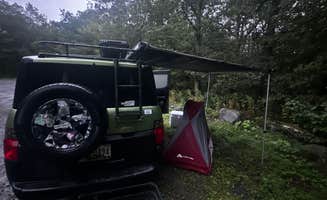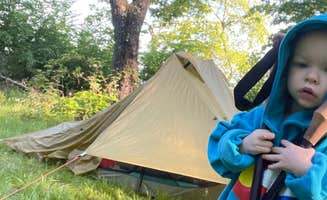Dispersed camping near Duryea, Pennsylvania encompasses several primitive sites in the mountainous northeastern region where elevations range from 700 to 1500 feet. The terrain features thick deciduous forest with rocky outcroppings and seasonal streams that typically run dry during summer months. Winter camping requires specialized gear due to temperatures regularly dropping below freezing from November through March, with snowfall accumulations making many access roads impassable without four-wheel drive vehicles.
What to do
Hiking network exploration: Multiple trailheads provide access to interconnected trail systems beyond the Appalachian Trail. Hickok Brook offers particularly challenging terrain with substantial elevation changes. "I drove in thinking that there would be flat places to park a very rugged camper in my full ton diesel pickup. The road is very rough with huge potholes so good clearance is a must," notes a camper at Hickok Brook.
Rock scrambling: The Blue Mountain ridge provides technical rock scrambling opportunities for experienced hikers seeking greater challenges than standard trail hiking. The Bake Oven Knob area features exposed rock formations with panoramic views. "The hike to the overlook is really lovely; short and rocky," shares a visitor about Bake Oven Knob.
Wildlife observation: Dawn and dusk provide optimal viewing times for white-tailed deer, wild turkey, and various raptor species. The Appalachian Trail Designated Backpacker Campsite 2 offers strategic positioning near wildlife corridors. "We stayed here during our section hike through the DWG on the AT. There's plenty of space. We camped nearer to others but there are secluded spots too," explains one camper about the Appalachian Trail Designated Backpacker Campsite 2.
What campers like
Hammock-friendly terrain: Many sites feature mature trees properly spaced for hammock camping as an alternative to ground sleeping on the rocky terrain. "Good trees for hammocking. We had thought there was a shelter (there isn't) but it was fine," reports a camper at Appalachian Trail Designated Backpacker Campsite 2.
Solitude opportunity: Weekday camping, particularly Monday through Thursday, provides significantly reduced encounter rates with other hikers or campers. "There are only 3 spots where we are. No motor vehicles beyond where I'm camping. Bring everything with you. It's a hike back to town... Really is a nice quiet place," explains one visitor to Hickok Brook.
Bear management infrastructure: Multiple sites provide bear boxes for food storage, eliminating the need to hang food bags. "Well maintained w bear boxes provided," notes a camper about the Appalachian Trail Designated Backpacker Campsite 2.
What you should know
Permit requirements: Camping regulations vary by specific location and managing authority. "Need a permit on NY state land. Contact Rangers office of whatever county," advises a camper at Hickok Brook.
Limited designated sites: Many areas restrict camping to established sites only despite the remote setting. "As you enter the Worthington State Forest there are signs and hand painted maps indicating that this is the only place you can sleep in the forest," explains a visitor to Appalachian Trail Designated Backpacker Campsite 2.
Water planning necessity: Natural water sources are unreliable and often require significant walking distance from campsites. "No Water (nearest is sunfish pound- easy hike about a 1 mile round trip)," shares one camper about Appalachian Trail Designated Backpacker Campsite 2.
Tips for camping with families
Overnight trial option: Thunder Swamp Trailhead provides a compromise between primitive camping and vehicle access for families testing equipment or younger children's camping readiness. "It's a gravel parking lot. Plenty of shade. No one bothered me," shares one visitor.
Proximity planning: Selecting sites within 0.5 miles of trailhead access points allows for easier gear transport when camping with children. "Trailhead parking was chill for a night. No trouble. Tons of hiking. Went down Saw Creek trail to a marsh," notes a camper at Thunder Swamp Trailhead.
Emergency exit strategy: Cellular coverage varies significantly throughout the region, requiring families to plan communication strategies for potential early departure needs. "It's Labor Day weekend, see how many people try to cram in to the very limited camping area," cautions a visitor to Hickok Brook regarding potential crowding during holidays.
Tips from RVers
Van camping alternatives: Appalachian Trail Campsite parking areas accommodate self-contained vans or small RVs without providing traditional hookups or services. "I've overnighted in my van here a bunch, no problems. This spot is both part of the Appalachian Trail and a day hiking area for the Bake Oven Knob," explains one visitor to Bake Oven Knob.
Clearance considerations: Many access roads require high-clearance vehicles with sturdy tires due to unmaintained conditions with rocks, ruts, and seasonal erosion. "The road is very rough with huge potholes so good clearance is a must. It's not a good spot for car camping," warns a visitor to Hickok Brook.
Parking lot selection: Multiple trailheads offer overnight parking for self-contained vehicles with varying space limitations. "There are two large lots. You can park and sleep, or hike in and find a place for a tent," shares a camper at Bake Oven Knob.




